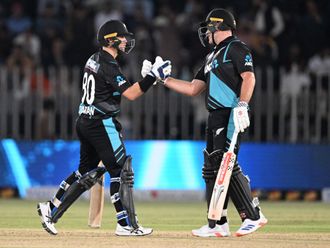London: There had never been a 6ft 5in fast left-arm bowler who could bat until Mitchell Starc came along to spearhead Australia’s attack.
It is no exaggeration to say that Starc could become one of Australia’s finest all-rounders, conceivably the equal of Alan Davidson because of his ability to swing the ball at 90mph, coupled with his intelligence and work ethic.
Starc clearly retains the drive that made his grandfather emigrate, but it is hidden beneath such a pleasant exterior that critics have wondered whether he is too nice to be a fast bowler.
He leaves the snarling to his opening partner, James Pattinson. “My dad’s parents are from what is now the Czech Republic,” he said. “Dad was born in Australia and played under-age baseball for New South Wales.
“He was coach of the junior side I started playing cricket for, Berala Sports in Sydney. I didn’t start bowling until I was 15 because all through junior cricket I was a wicketkeeper,” Starc said.
“The coach told me ‘if you want to make this team in the Green Shield competition’ — between junior and grade — ‘you’re going to have to do it as a bowler’.
“That’s when I put away the gloves and learned how to bowl properly. Being 6ft 5in now, it was obviously a good decision — and there was less exposure to the hard concrete synthetic wickets that we have in junior cricket.
“I guess I didn’t have all that impact going through my body at a young stage.”
Rare for his type, he has had no stress fractures. The run-up came naturally, he says, and a wonderfully athletic one it is, like Davidson’s. “Alan Davidson actually played for my club Western Suburbs and I’ve had some interaction with him,” he said.
“I’ve also had the chance to talk to Wasim Akram about natural and reverse-swing.”
Because Starc can bowl reverse-swing from round the wicket, he can avoid creating a rough patch for Graeme Swann’s offbreaks, as New Zealand’s Trent Boult did in the Headingley Test.
Alastair Cook had difficulty when Boult and his fellow left-armer Neil Wagner drew him into the drive; and Starc’s nascent, nine-Test record is better against left-handed batsmen. “I don’t keep the stats, but moving the ball away from left-handers is a pretty good weapon for me.”
Batting start
If having a left-arm bowler is one advantage that Australia have over England, another is a stronger tail. Australia’s last four batsmen average 89 runs to England’s 69, and this is largely thanks to Starc averaging 32, with a top score of 99 against India filled with clean drives.
“One of my best mates runs an indoor centre down the road from where I live and I was a batsman before I was a bowler. I guess I was more of a slogger but I really enjoy working on it and, going through a few injuries, that’s when I’d work on my batting and play grade cricket as a batsman, rather than sit at home.
“At Western Suburbs I played a few games of second grade at No 6 and scored a century — 111 or something like that — and the week after that I batted in first grade and made 40-odd.”
There are not many tales of injured England bowlers playing Premier League as batsmen. Another indication of Starc’s mettle came when he turned down the Indian Premier League. “I chose to play county cricket for Yorkshire last year to develop my cricket with the hope of coming on this tour. Financially it [IPL] would have been brilliant, but it wasn’t a hard decision — I want to play as much Test cricket as I can.
“I hadn’t been to England before so it was good exposure to some of the county grounds, playing alongside Joe Root, Jonny Bairstow and Tim Bresnan. I hadn’t bowled with a Duke ball before so it was nice to learn off Jason Gillespie, the coach at Yorkshire, and have Ryan Sidebottom as well to pick his brains.”
Now it is England’s turn to deal with the Starc reality.
— The Telegraph Group Limited, London 2013












